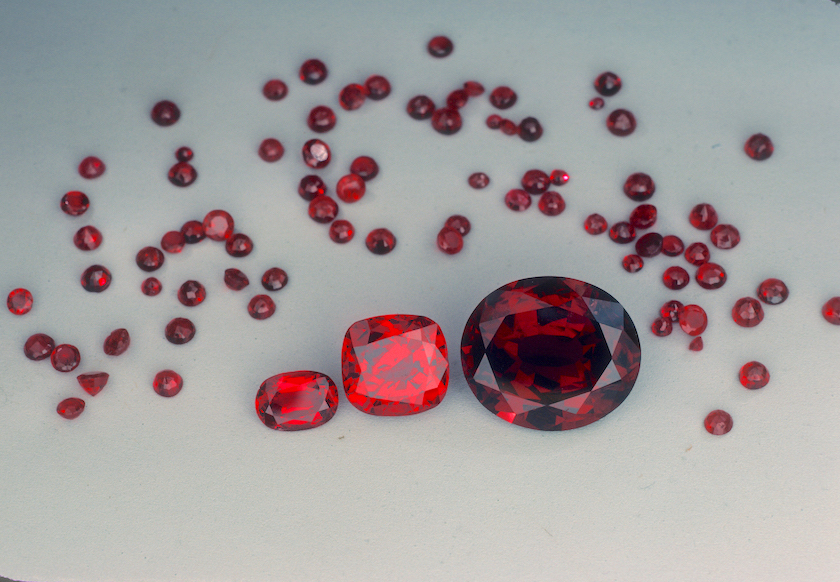Basics of Gemstone Density and Specific Gravity
Gemologists sometimes measure gemstone density or specific gravity to help with gem identification. Learn the basics of this property and how to test it.
2 Minute Read
What is Density?
In case you forgot your high school science, density refers to how much mass something has per unit of volume. Or, think of density as the "compactness" of an item. For example, vegetable oil is less dense than vinegar. Thus, the oil floats on top of the vinegar and spices when a salad dressing separates.
Gemstone density or specific gravity are bulk properties independent of direction and typically uniform within a mass of material. Under ideal circumstances, two gems of the same species and variety have the same density. However, nature rarely obliges. In the real world, mineral density varies widely, even within a single crystal, due to impurities, cracks, and bubbles. Nevertheless, density is a useful parameter in gem identification. Therefore, you should understand these variable factors.
Specific gravity is the ratio expressing the weight of a given material compared to that of an equal volume of water at 4° C. Thus, a specific gravity of 3 means that, at 4° C, one cubic centimeter of the material in question weighs 3 times as much as one cubic centimeter of water.
What Determines Gemstone Density?
The density of a compound is a function of several factors, including chemical composition and crystal structure. For example, consider diamond and graphite. Both are polymorphous crystalline forms of the element carbon (C). Since diamond's structure packs its carbon atoms tightly, it has a density of 3.5. Graphite has a much looser, open structure. So, it has a density of only 2.2.
The density of minerals within a solid solution series may vary linearly with composition change. You can see chemical substitution's effect quite dramatically in the example of the orthorhombic carbonate minerals aragonite and cerussite. Aragonite is CaCO3 and has a specific gravity of 2.95. Cerussite has the same crystal structure as aragonite. However, it has a chemical composition of PbCO3 and a specific gravity of 6.55! This clearly shows the role of lead (Pb) versus calcium (Ca) in the structure.
How to Measure Gemstone Density
Gemologists usually measure specific gravity with heavy liquids. They prepare a liquid, such as a mixture of bromoform and toluene, to have a particular density value. When an unknown material is dropped into the liquid, it may sink, float, or remain suspended in place. If the material sinks, it has greater density than the liquid. If it floats, it has less density than the liquid. Should it remain suspended at one level, it has the same density as the liquid. You can take very accurate specific gravity measurements by changing the density of a column of liquid through temperature variations. In addition, you can suspend density standards in the column.
As an alternative method, you can use so-called torsion balances, such as the Hanneman balance or a Berman scale. First, weigh your sample in air. Then, weigh it suspended in a liquid, such as water or toluene. You can measure the weights in both media quite accurately, sometimes reporting specific gravities to two decimal places.
What Can Interfere With Density Measurements?
The presence of impurities within crystals poses a major problem for all gemstone density measurements. These impurities hardly ever have the same specific gravity as the host material. As a result, they can limit the usefulness of specific gravity testing for gem identification.
Surface tension may also "float" a mineral grain in both heavy liquids and a torsion balance. This results in erroneously low specific gravity measurements.
Accurate density measurement involves absolute cleanliness, great care in specimen preparation, precise temperature control, and replicate measurements.
Joel E. Arem, Ph.D., FGA
Dr. Joel E. Arem has more than 60 years of experience in the world of gems and minerals. After obtaining his Ph.D. in Mineralogy from Harvard University, he has published numerous books that are still among the most widely used references and guidebooks on crystals, gems and minerals in the world.
Co-founder and President of numerous organizations, Dr. Arem has enjoyed a lifelong career in mineralogy and gemology. He has been a Smithsonian scientist and Curator, a consultant to many well-known companies and institutions, and a prolific author and speaker. Although his main activities have been as a gem cutter and dealer, his focus has always been education. joelarem.com
Related Articles
What are Allochromatic and Idiochromatic Gems?
What are Lab-Grown Sapphires?
What is Gemstone Dispersion?
Understanding Gem Synthetics, Treatments, and Imitations, Part 5: Gemstone Treatments
Latest Articles
800 Years of Mogok: A Celebration in Tenuous Times
What is the Average Gemstone Faceting Yield?
Pyroxmangite Value, Price, and Jewelry Information
How to Identify Emerald Simulants and Synthetics
Never Stop Learning
When you join the IGS community, you get trusted diamond & gemstone information when you need it.
Get Gemology Insights
Get started with the International Gem Society’s free guide to gemstone identification. Join our weekly newsletter & get a free copy of the Gem ID Checklist!
